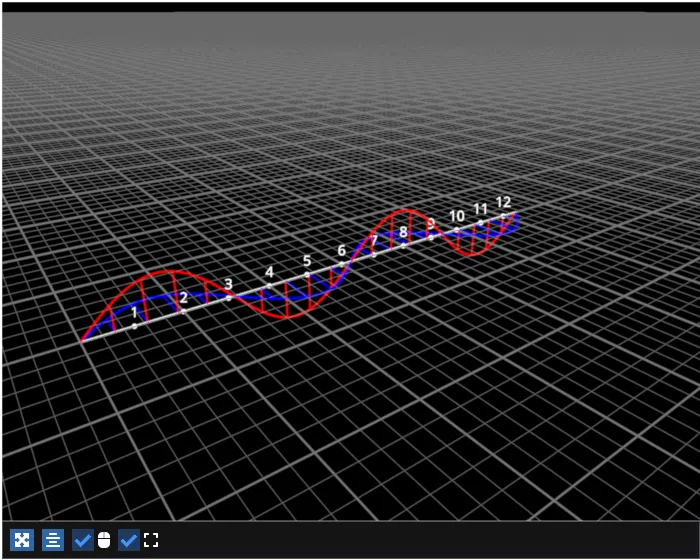Note
Go to the end to download the full example code.
Electromagnetic Wave Animation#
Example showing animation of an electromagnetic wave.

/opt/hostedtoolcache/Python/3.12.12/x64/lib/python3.12/site-packages/pygfx/objects/_ruler.py:400: RuntimeWarning: divide by zero encountered in divide
screen_full = (ndc_full[:, :2] / ndc_full[:, 3:4]) * half_canvas_size
/opt/hostedtoolcache/Python/3.12.12/x64/lib/python3.12/site-packages/pygfx/objects/_ruler.py:400: RuntimeWarning: invalid value encountered in divide
screen_full = (ndc_full[:, :2] / ndc_full[:, 3:4]) * half_canvas_size
/opt/hostedtoolcache/Python/3.12.12/x64/lib/python3.12/site-packages/pygfx/objects/_ruler.py:412: RuntimeWarning: invalid value encountered in divide
screen_sel = (ndc_sel[:, :2] / ndc_sel[:, 3:4]) * half_canvas_size
/home/runner/work/fastplotlib/fastplotlib/fastplotlib/graphics/features/_base.py:18: UserWarning: casting float64 array to float32
warn(f"casting {array.dtype} array to float32")
(<weakproxy at 0x7ff4ce5ca660 to Line at 0x7ff4ce6d75c0>, <weakproxy at 0x7ff4ce5caca0 to Line at 0x7ff4ce6d7650>, <weakproxy at 0x7ff4ce5cb5b0 to Group at 0x7ff4ce6d4a40>, <weakproxy at 0x7ff4ce63bf60 to Group at 0x7ff4ce2bb2c0>)
# test_example = false
import fastplotlib as fpl
import numpy as np
figure = fpl.Figure(
cameras="3d",
controller_types="orbit",
size=(700, 560)
)
start, stop = 0, 4 * np.pi
# let's define the x, y and z axes for each with direction of wave propogation along the z-axis
# electric field in the xz plane travelling along
zs = np.linspace(start, stop, 200)
e_ys = np.zeros(200)
e_xs = np.sin(zs)
electric = np.column_stack([e_xs, e_ys, zs])
# magnetic field in the yz plane
zs = np.linspace(start, stop, 200)
m_ys = np.sin(zs)
m_xs = np.zeros(200)
magnetic = np.column_stack([m_xs, m_ys, zs])
# add the lines
figure[0, 0].add_line(electric, colors="blue", thickness=2, name="e")
figure[0, 0].add_line(magnetic, colors="red", thickness=2, name="m")
# draw vector line at every 10th position
electric_vectors = [np.array([[0, 0, z], [x, 0, z]]) for (x, z) in zip(e_xs[::10], zs[::10])]
magnetic_vectors = [np.array([[0, 0, z], [0, y, z]]) for (y, z) in zip(m_ys[::10], zs[::10])]
# add as a line collection
figure[0, 0].add_line_collection(electric_vectors, colors="blue", thickness=1.5, name="e-vec")
figure[0, 0].add_line_collection(magnetic_vectors, colors="red", thickness=1.5, name="m-vec")
# note that the z_offset in `add_line_collection` is not data-related
# it is the z-offset for where to place the *graphic*, by default with Orthographic cameras (i.e. 2D views)
# it will increment by 1 for each line in the collection, we want to disable this so set z_position=0
# just a pre-saved camera state
state = {
'position': np.array([-8.0 , 6.0, -2.0]),
'rotation': np.array([0.09, 0.9 , 0.2, -0.5]),
'scale': np.array([1., 1., 1.]),
'reference_up': np.array([0., 1., 0.]),
'fov': 50.0,
'width': 12,
'height': 12,
'zoom': 1.35,
'maintain_aspect': True,
'depth_range': None
}
figure[0, 0].camera.set_state(state)
# make all grids except xz plane invisible to remove clutter
figure[0, 0].axes.grids.xz.visible = True
figure.show()
figure[0, 0].camera.zoom = 1.5
increment = np.pi * 4 / 100
# moves the wave one step along the z-axis
def tick(subplot):
global increment, start, stop, zs
new_zs = np.linspace(start, stop, 200)
new_data = np.sin(new_zs)
# just change the x-axis vals for the electric field
subplot["e"].data[:, 0] = new_data
subplot["e"].data[:, 2] = new_zs
# and y-axis vals for magnetic field
subplot["m"].data[:, 1] = new_data
subplot["m"].data[:, 2] = new_zs
# update the vector lines
for i, (value, z) in enumerate(zip(new_data[::10], new_zs[::10])):
subplot["e-vec"].graphics[i].data = np.array([[0, 0, z], [value, 0, z]])
subplot["m-vec"].graphics[i].data = np.array([[0, 0, z], [0, value, z]])
# update axes and center scene
subplot.axes.z.start_value = start
subplot.axes.z.update(subplot.camera, subplot.viewport.logical_size)
subplot.center_scene()
start += increment
stop += increment
figure[0, 0].axes.x.visible = False
figure[0, 0].axes.y.visible = False
figure[0, 0].axes.auto_grid = False
figure[0, 0].add_animations(tick)
print(figure[0, 0]._fpl_graphics_scene.children)
# NOTE: fpl.loop.run() should not be used for interactive sessions
# See the "JupyterLab and IPython" section in the user guide
if __name__ == "__main__":
print(__doc__)
fpl.loop.run()
Total running time of the script: (0 minutes 23.379 seconds)
